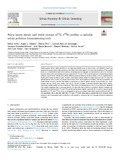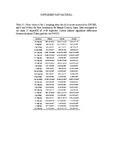Mostrar el registro sencillo del ítem
Foliar heavy metals and stable isotope (δ13C, δ15N) profiles as reliable urban pollution biomonitoring tools
| dc.creator | Soba Hidalgo, David | es_ES |
| dc.creator | Gámez Guzmán, Angie Lorena | es_ES |
| dc.creator | Úriz, Naroa | es_ES |
| dc.creator | Ruiz de Larrinaga, Lorena | es_ES |
| dc.creator | González Murua, Carmen | es_ES |
| dc.creator | Becerril, José María | es_ES |
| dc.creator | Esteban Terradillos, Raquel | es_ES |
| dc.creator | Serret, Dolors | es_ES |
| dc.creator | Araus, José Luis | es_ES |
| dc.creator | Aranjuelo Michelena, Iker | es_ES |
| dc.date.accessioned | 2021-06-21T10:03:34Z | |
| dc.date.available | 2021-06-21T10:03:34Z | |
| dc.date.issued | 2021 | |
| dc.identifier.issn | 1618-8667 | |
| dc.identifier.uri | https://hdl.handle.net/2454/40004 | |
| dc.description | Incluye material complementario | es_ES |
| dc.description.abstract | Anthropogenic heavy metal pollution is an important health issue in urban areas, and therefore rapid and inexpensive monitoring in time and space is desirable. This study aimed (i) to assess the suitability of Tilia cordata leaves as a valuable heavy metal bioindicator, including seasonal changes in concentrations and (ii) to evaluate the use of leaf carbon and nitrogen isotope composition (δ13C and δ15N) as novel indicators of urban heavy metal pollution. Leaves were collected from three different pollution intensity locations (Bilbao, Vitoria, and Muskiz) in the Basque Country (northern Spain). Analysis of leaf heavy metals related to traffic emissions and δ13C and δ15N determinations were carried out during July-October 2018. Leaf samples from Bilbao, the most populated and traffic-intense location, showed the highest concentration of heavy metals (mainly from polluted air). Additionally, the two urban areas, Bilbao and Vitoria, showed stronger correlation between these heavy metals, indicating a traffic-related source of emissions. The source of contamination (soil or air) in relation to elements and optimal sampling time is discussed herein. On the other hand, Pearson correlation analysis revealed significant trends between leaf δ13C and δ15N and the studied heavy metals, especially Pb, Cr and Cd, supporting the hypothesis of δ13C and δ15N as tools to distinguish locations according to their heavy metal pollution levels. To our knowledge, this is the first time that δ13C and δ15N have been used as monitoring tools in heavy metal pollution and consequently more research is still needed to calibrate this tool through extensive vegetation screening. | en |
| dc.description.sponsorship | This research was supported by the Spanish Government [AGL 2015-64481-C2-1-R] and the Basque Government [UPV/EHU-GV IT-1018-16]. RE received a Juan de la Cierva incorporation contract IJCI-2014-21452. | en |
| dc.format.extent | 11 p. | |
| dc.format.mimetype | application/pdf | en |
| dc.format.mimetype | application/zip | en |
| dc.language.iso | eng | en |
| dc.publisher | Elsevier | en |
| dc.relation.ispartof | Urban Forestry & Urban Greening 57 (2021) 126918 | en |
| dc.rights | © 2020 The Authors. This is an open access article under the CC BY-NC-ND license | en |
| dc.rights.uri | http://creativecommons.org/licenses/by-nc-nd/4.0/ | |
| dc.subject | C and N isotopic composition | en |
| dc.subject | Element profiling | en |
| dc.subject | Soil contamination | en |
| dc.subject | Strontium | en |
| dc.subject | Tiliacordata Mill. | en |
| dc.subject | Traffic pollution | en |
| dc.title | Foliar heavy metals and stable isotope (δ13C, δ15N) profiles as reliable urban pollution biomonitoring tools | en |
| dc.type | info:eu-repo/semantics/article | en |
| dc.type | Artículo / Artikulua | es |
| dc.contributor.department | Agronomía, Biotecnología y Alimentación | es_ES |
| dc.contributor.department | Agronomia, Bioteknologia eta Elikadura | eu |
| dc.rights.accessRights | info:eu-repo/semantics/openAccess | en |
| dc.rights.accessRights | Acceso abierto / Sarbide irekia | es |
| dc.identifier.doi | 10.1016/j.ufug.2020.126918 | |
| dc.relation.projectID | info:eu-repo/grantAgreement/MINECO//AGL2015-64481-C2-1-R/ES/ | en |
| dc.relation.projectID | info:eu-repo/grantAgreement/MINECO//IJCI-2014-21452/ES/ | en |
| dc.relation.publisherversion | https://doi.org/10.1016/j.ufug.2020.126918 | |
| dc.type.version | info:eu-repo/semantics/publishedVersion | en |
| dc.type.version | Versión publicada / Argitaratu den bertsioa | es |




